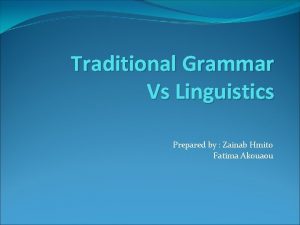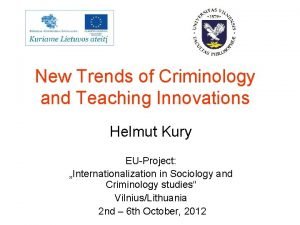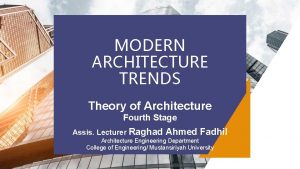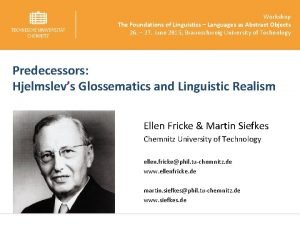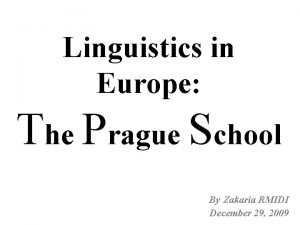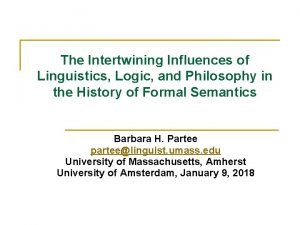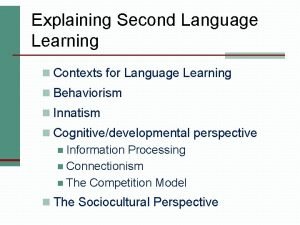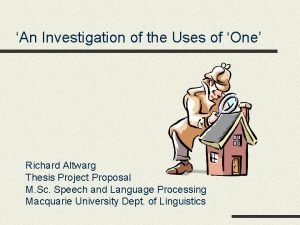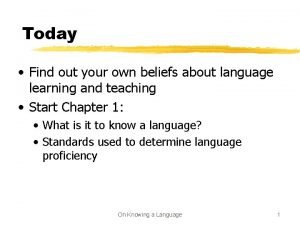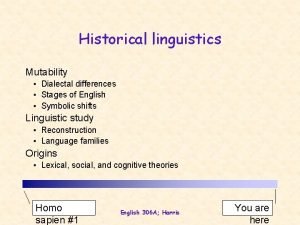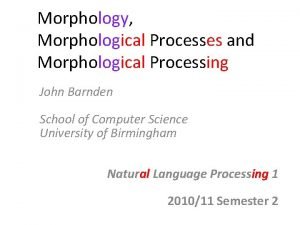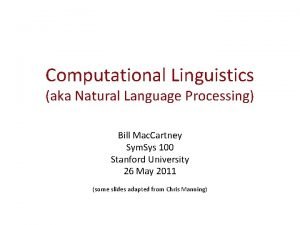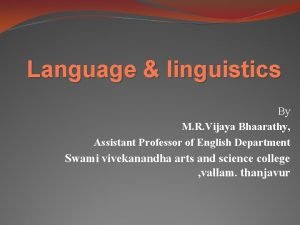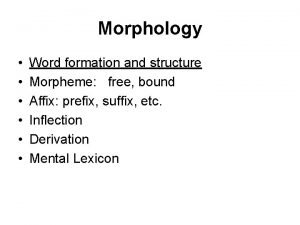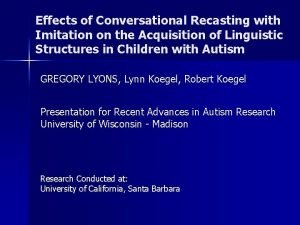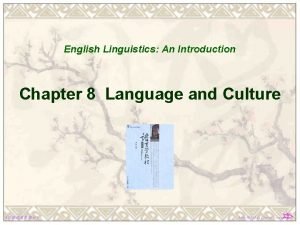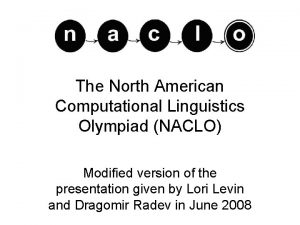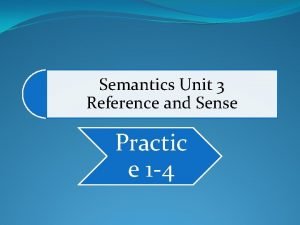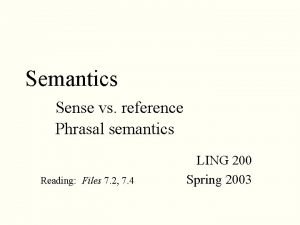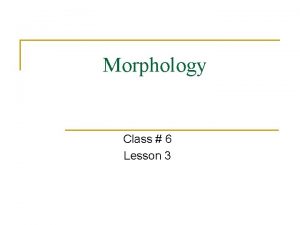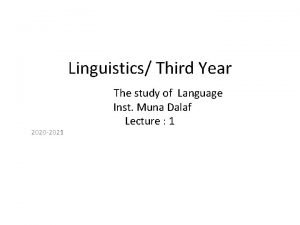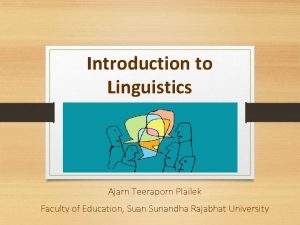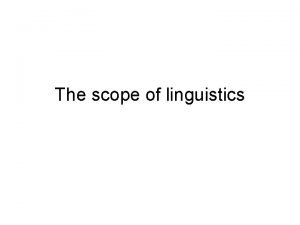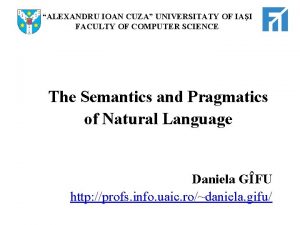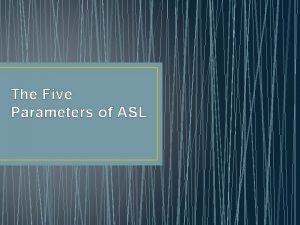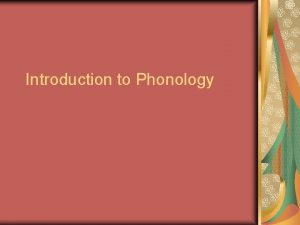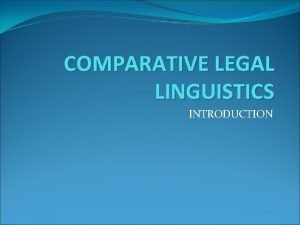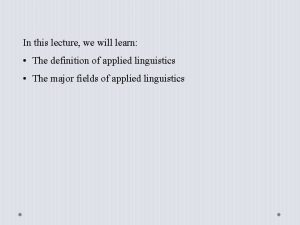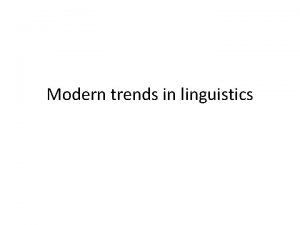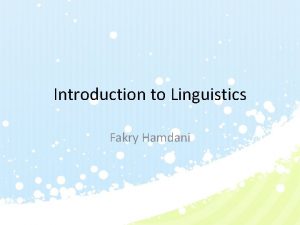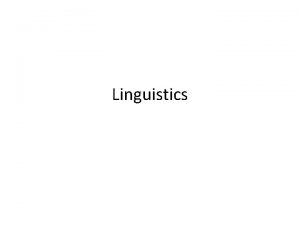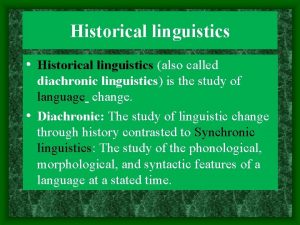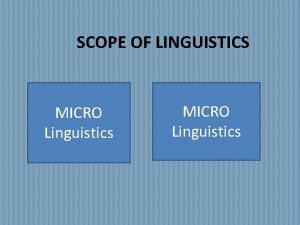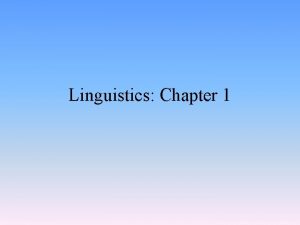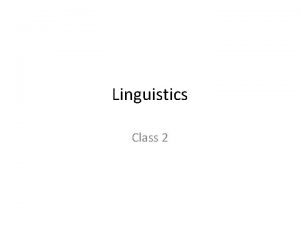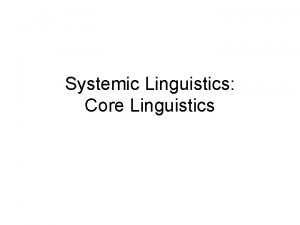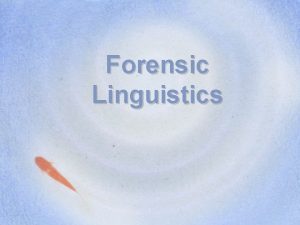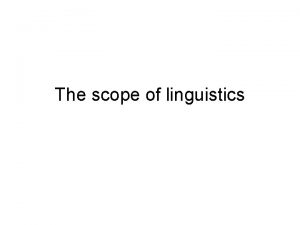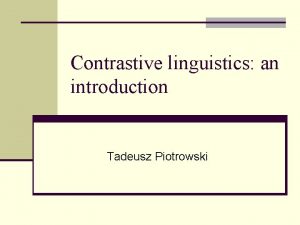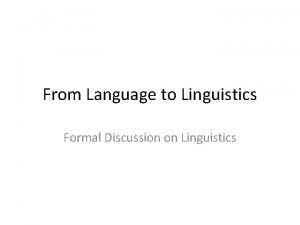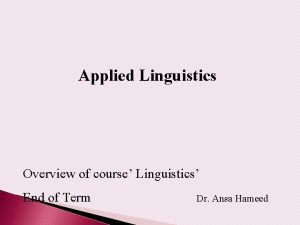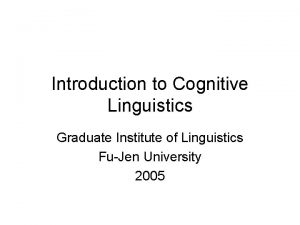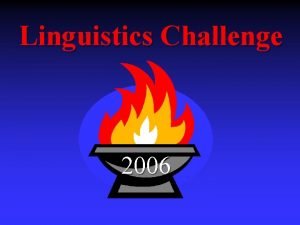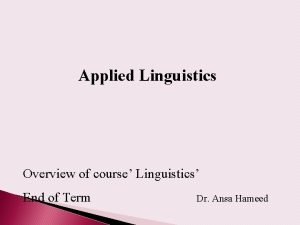Modern trends in linguistics Modern trends in linguistics





































- Slides: 37

Modern trends in linguistics

Modern trends in linguistics 1. 2. 3. 4. Cognitive linguistics. Functional grammar. Text linguistics. Communicative linguistics.

Linguistics in the 20 th century comparative linguistics structural linguistics • genesis • system communicative linguistics • function

Cognitive linguistics is an approach to the analysis of natural language that originated in the late 1970 s and early 1980 s in the work of US linguists George Lakoff, Ron Langacker, and Len Talmy, and that focuses on language as an instrument for organizing, processing, and conveying information. It emerged as a reaction against the dominant generative paradigm.

Cognitive linguistics • language is not autonomous, it is embedded in the overall cognitive capacities of man; there is no autonomous linguistic faculty in human mind • the formal structures of language are studied as reflections of general conceptual organization, categorization principles, processing mechanisms, and experiential and environmental influences • linguistic knowledge involves not just knowledge of the language, but knowledge of the world as mediated by the language • knowledge of language arises out of language use; the study of language is the study of language use

Cognitive linguistics • our interaction with the world is mediated through informational structures in the mind • natural language is a means for organizing, processing, and conveying that information. • language is seen as a repository of world knowledge, a structured collection of meaningful categories that help us deal with new experiences and store information about old ones.

Cognitive linguistics Three fundamental characteristics of Cognitive Linguistics: • the primacy of semantics in linguistic analysis (the primary function of language is categorization, it involves meaning) • the encyclopedic nature of linguistic meaning (world knowledge is associated with linguistic forms) • the perspectival nature of linguistic meaning (the world is not objectively reflected in the language: the categorization function of the language imposes a structure on the world rather than just mirroring objective reality)

Cognitive linguistics Generative linguistics vs Cognitive linguistics Generative linguistics: how knowledge of language can be acquired through a cognitive theory of learning there can be no knowledge without the existence of a mental representation that has a constitutive, mediating role in the epistemological relationship between subject and object. Cognitive linguistics: how natural language contributes to our knowledge of the world

Cognitive linguistics • develops a rich conception of grammar that reflects fundamental cognitive abilities: the ability to form structured conceptualizations with multiple levels of organization, to conceive of a situation at varying levels of abstraction, to establish correspondences between facets of different structures, and to construe the same situation in alternate ways

Cognitive linguistics

Cognitive linguistics • Language does not "represent" meaning; it prompts for the construction of meaning in particular contexts with particular cultural models and cognitive resources. The speaker is guided along the same mental paths, being prompted to perform complex cognitive operations. Thus, a large part of cognitive linguistics centers on the creative on-line construction of meaning as discourse unfolds in context.

Cognitive linguistics • study of metaphor and metonymy as powerful conceptual mappings at the very core of human thought, important not just for the understanding of poetry, but also science, mathematics, religion, philosophy, and everyday speaking and thinking Metaphor is not just a figure of speech! In the scheme of evolution, metaphor, based on human experience and neural connections to our embodied sensations, actions, and emotions, is what creates the possibility of 'abstract' reasoning, scientific and mathematical thought, philosophical speculation, in other words language and culture quite generally. Metaphor gives the mind the power that it has.

Cognitive linguistics Prototypes and concepts Prototypes are an idealized, internalized conceptualization of an object reality.

Cognitive linguistics Frame semantics • Frame semantics is a theory of linguistic meaning developed by Charles J. Fillmore. • It relates linguistic semantics to encyclopaedic knowledge. • The basic idea is that one cannot understand the meaning of a single word without access to all the essential knowledge that relates to that word. • A semantic frame is a collection of facts that specify "characteristic features, attributes, and functions of a denotatum, and its characteristic interactions with things necessarily or typically associated with it”.

Functional grammar Functional Grammar (FG), as developed by the Dutch linguist Simon Dik and others, is a general theory of the organization of natural language. FG seeks to be a theory which is 'functional' in at least three different, though interrelated senses: • It takes a functional view on the nature of language; • It attaches primary importance to functional relations at different levels in the organization of grammar; • It wishes to be practically applicable to the analysis of different aspects of language and language use.

Functional grammar The following standards of adequacy are of particular importance for theory of FG: • TYPOLOGICAL ADEQUACY: theory should be formulated in terms of rules and principles which can be applied to any type of natural language. • PRAGMATIC ADEQUACY: what theory says about a language should be such as to help us understand how linguistic expressions can be effectively used in communicative interaction. • PSYCHOLOGICAL ADEQUACY: what theory says about a language should be compatible with what is known about the psychological mechanisms involved in natural language processing.

Functional grammar In FG, functional notions play essential and fundamental roles at different levels of grammatical organization. Three types or levels of functions are distinguished: • SEMANTIC FUNCTIONS (Agent, Patient, Recipient, etc. ) which define the roles that participants play in states of affairs. • SYNTACTIC FUNCTIONS (Subject and Object) which define different perspectives through which states of affairs are presented in linguistic expressions. • PRAGMATIC FUNCTIONS (Theme and Tail, Topic and Focus) which define the informational status of constituents of linguistic expressions.

Functional grammar Alexander Bondarko (1930 -2016) “Functional Grammar: A Field Approach” the author of theory of Functional Semantic Fields (FSF)

Functional grammar FSF is a system of language units of various levels (lexical, morphological, syntactical) which perform the same function on the basis of their common categorial content (modality, temporality, possessiveness, aspectuality, intensity etc. ) ФСО спонукальності

Text linguistics is a branch of linguistics concerned with the description and analysis of extended texts (either spoken or written) in communicative contexts. Text linguistics overlaps considerably with discourse analysis.

Text linguistics “. . . it has become obvious to a growing number of linguists that the study of the syntax of isolated sentences, extracted without natural context from the purposeful constructions of speakers is a methodology that has outlived it usefulness”. Thomas Givon, a US linguist “There are certain types of sentences which we cannot make sense of, either syntactically or semantically, without examining them with respect to a discourse context” Norman Gary a US linguist

Text linguistics Approaches to the study of texts • text grammar (Van Dijk) aims to establish a model with which the grammatical structures of texts can be described (quite similar to Chomsky’s transformational approach). • text linguistics is devoted to describing how texts are created and understood and in so doing studies the defining properties of texts - what constitutes their textuality or texture (Crystal). • discourse analysis (Renkema, Schiffrin) traditionally analyses chiefly written texts. However, it seems that it is very difficult to define “discourse” precisely - Schiffrin (1994) for example says that discourse analysis “. . . is one of the most vast, but also least defined, areas in linguistics”.

Text linguistics A text is defined as a communicative occurrence which meets seven standards (principles) of textuality: • cohesion, • coherence, • intentionality, • acceptability, • informativity, • contextuality • and intertextuality.

Text linguistics Cohesion M. Halliday , R. Hasan “Cohesion in English” (1976) “The concept of cohesion accounts for the essential semantic relations whereby any passage of speech or writing is enabled to function as text” Categories of cohesion provide a practical means for describing and analysing texts. They are explicitly expressed in a text: • reference, • substitution, • ellipse, • conjunction • lexical cohesion (synonymy, antonymy, collocation).

Text linguistics Coherence is probably the main component of any form of textual study because if a text is not fully understood a ‘good’ text was not produced. What makes a text “coherent”? What makes some texts “acceptable” and others “unacceptable”? A coherent text has an underlying logical structure that acts to guide the reader through the text so that “it ‘sticks together’ as a unit and creates the feeling that a text hangs together, that it makes sense, and is not just a jumble of sentences.

Text linguistics

Text linguistics Intentionality and acceptability are generally regarded as a ‘pair’ of principles. In any text there is a producer who has the intention to produce a sound piece of information to a receptor. The receptor needs to be willing to accept the proffered text as a communicative text. In order to do this both producer and addressee have to adhere to the pragmatic cooperative principle which states that one has to make the maximum effort to enable a piece of intended communication to be a success.

Text linguistics Informativity has to do with the way in which parts of the text have communicative value. Which is more informative? a man with a golden gun him (pronoun)

Text linguistics Contextuality focuses on the role the context plays in any form of communication. I In every situation in which language is used, the quality and effect of the communication is determined by the contextual knowledge shared by the participants. This aspect of language use is studied by pragmatics and sociolinguistics. Pragmatics focuses on what the participants in a discourse intend to accomplish through the use of the language (what speech act is performed in a given setting). Sociolinguistics aims to determine the role knowledge of the participants (as human beings and in the environment they function as such) plays in the success of a communicative occurrence.

Text linguistics Intertextuality means that the formation and understanding of one text will be influenced by the structure of another text similar to it.

Text linguistics is a kind of umbrella discipline which makes the study of the different disciplines of linguistics more relevant. Principle of textuality Linguistic sub-disciplines Cohesion Syntax Semantics Morphology Phonology Coherence Semantics Cognitive linguistics Intentionality Pragmatics Acceptability Pragmatics Informativity Semantics Syntax Contextuality Pragmatics Sociolinguistics Intertextuality Literature theory

Communicative linguistics Text linguistics and discourse analysis are directly connected with communicative linguistics which studies speech communication, involving the following components: • speaker • addressee • message • context • specifics of contact • message code (means)

Communicative linguistics Paul Grice (1913 -1988), British philosopher of language Maxims of effective communication • Maxim of Quality Supermaxim: • Try to make your contribution one that is true Submaxims: • Do not say what you believe to be false. • Do not say that for which you lack adequate evidence. • Maxim of Quantity Make your contribution as informative as is required (for the current purposes of the exchange). Do not make your contribution more informative than is required. • Maxim of Relevance Be Relevant • Maxim of Manner Supermaxim: Be clear and keen Submaxims: • Avoid obscurity of expression. • Avoid ambiguity. • Be brief. • Be orderly.

Communicative linguistics Speech-act theory is a subfield of pragmatics concerned with the ways in which words can be used not only to present information but also to carry out actions. As introduced by Oxford philosopher J. L. Austin (“How to Do Things With Words”, 1962) and further developed by American philosopher J. R. Searle, speech-act theory considers the levels of action at which utterances are said to perform: • Locutionary Acts • Illocutionary Acts • Perlocutionary Acts


Communicative linguistics

Communicative linguistics Communicative competence refers to both the knowledge of a language and the ability to use it effectively. The concept of communicative competence (a term coined by linguist Dell Hymes in 1972) grew out of resistance to the concept of linguistic competence introduced by Noam Chomsky (1965). Most scholars now consider linguistic competence to be a part of communicative competence.
 Language
Language Linguistics vs applied linguistics
Linguistics vs applied linguistics Strength and weakness of traditional grammar
Strength and weakness of traditional grammar Modern trends of foreign trade in india
Modern trends of foreign trade in india Modern trends in criminology
Modern trends in criminology What are the trends in the periodic table
What are the trends in the periodic table Trends in project portfolio management
Trends in project portfolio management Modern architecture trends
Modern architecture trends Double articulation
Double articulation Roman jakobson
Roman jakobson Linguistics
Linguistics Child directed speech definition
Child directed speech definition Anaphora linguistics
Anaphora linguistics Competence vs performance in linguistics
Competence vs performance in linguistics Mutability linguistics
Mutability linguistics Morphological processes
Morphological processes Xkcd computational linguistics
Xkcd computational linguistics Importance of linguistics
Importance of linguistics Systemic functional linguistics for dummies
Systemic functional linguistics for dummies Word formation amaze
Word formation amaze Recasting child language
Recasting child language What is cross cultural communication definition
What is cross cultural communication definition What is locutionary act
What is locutionary act Computational linguistics olympiad
Computational linguistics olympiad Reduplication in linguistics
Reduplication in linguistics Sense reference referent
Sense reference referent Sense vs reference linguistics examples
Sense vs reference linguistics examples Linguistics
Linguistics Tree diagram of morphemes
Tree diagram of morphemes Utterance definition linguistics
Utterance definition linguistics Which language
Which language Competence vs performance in linguistics
Competence vs performance in linguistics What is the scope of linguistics
What is the scope of linguistics Pragmatic definition in linguistics
Pragmatic definition in linguistics Who is the father of asl
Who is the father of asl Phonetics vs phonology
Phonetics vs phonology Legal linguistics
Legal linguistics Linguistics definition
Linguistics definition


